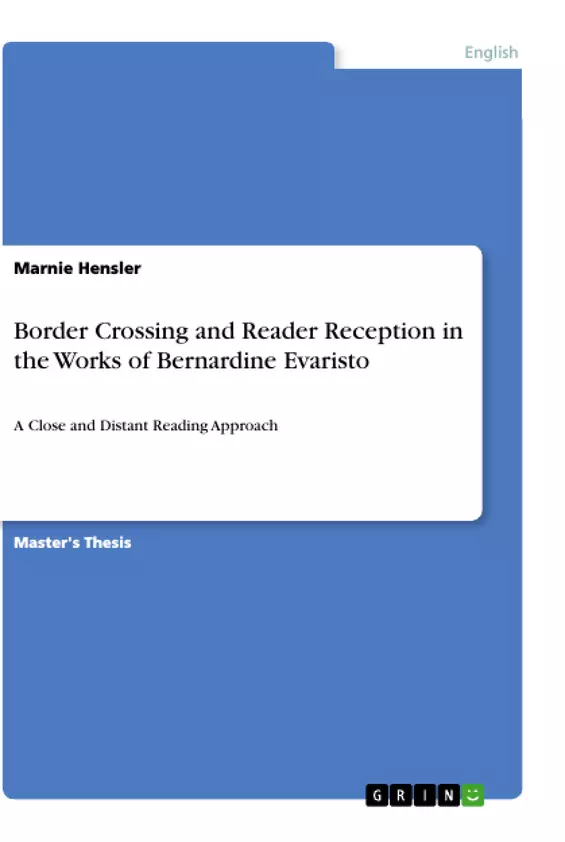This paper uses both distant and close reading methods to analyse reader reception of Bernardine Evaristo’s works “The Emperor’s Babe”, “Mr. Loverman” and her Booker Award winning publication “Girl, Woman, Other”. Through experimental form and style, approachable characters and humorous style of writing, Evaristo successfully draws the contemporary reader into the story world and educates her on the constructedness of cognitive borders and social categorizations (sex, gender, age, race, class et cetera). After the reader crosses the border into the story world, she follows the individual journeys of the fictional characters with the help of mind-reading and narrative empathy and leaves the story world with differences in cognitive processing” followed by effects on “cognition, perception and action.
To empirically analyse the educational, border-crossing effect of a literary work that reaches beyond the reading experience, this paper uses reception data from Goodreads in the form of reader profile information and reviews on “The Emperor’s Babe”, “Mr. Loverman” and “Girl, Woman, Other”. After a theoretical introduction to the historic development of the academic interest in both border and (empirical) reception studies, the results section will outline the major findings of a descriptive statistical analysis of the retrieved data for the reception of all novels. Each novel’s reception will then be looked at individually through distant and close reading of the respective book’s narrative techniques. A discussion section will compare the findings of the distant and close readings of all three books under discussion. The paper will close with a critical summary of the findings in the conclusion and give an outlook on the advantages and opportunities provided by the study of the subversive, border-crossing effects of literature in general.
The influence of fiction on a reader’s personal life and social cognition has been of interest to academia ever since the beginnings of reader-response criticism and the cognitive turn of the 1980s. Literature, after all, has the power to serve as a springboard for subversive thought, the precursory movement of a transformation of social and cultural structures. Reader response and reception theorists, cognitive literary critics and empirical receptionists have thus been trying to empirically explain the transformative, subversive powers of literature.
Inhaltsverzeichnis (Table of Contents)
- I. Border-Crossing Fiction
- II. Theoretical Introduction
- 1. Border Crossing and Reader Transportation
- 2. Reader-Response Criticism and Reception Theory
- 3. Cognitive Literary Studies: Theory of Mind & Narrative Empathy
- 4. The Empirical About Literary and Reception Studies
- III. Methodological Introduction
- IV. Results
- 1. General Findings
- 2. The Emperor's Babe (2001)
- a) Reader Profiles, Ratings and Reviews
- b) Historicity
- c) Zuleika
- d) Language
- e) Form
- 3. Mr. Loverman (2013)
- a) Reader Profiles, Ratings and Reviews
- b) Barry
- c) Carmel
- d) Morris
- e) Humour
- 4. Girl, Woman, Other (2019)
- a) Reader Profiles, Ratings and Reviews
- b) Intersectionality
- c) Polyphony
- d) Form
- e) Stereotyping
- V. Discussion
- VI. Conclusion & Outlook
- VII. Appendix
Zielsetzung und Themenschwerpunkte (Objectives and Key Themes)
This paper aims to analyze reader reception of Bernardine Evaristo's works, focusing on how her novels encourage readers to cross cognitive borders and engage with diverse perspectives. It examines how Evaristo's use of experimental forms, approachable characters, and humorous style fosters reader engagement and empathy.
- The impact of literature on social cognition and personal lives.
- The subversive and transformative power of literature.
- The role of narrative techniques in shaping reader reception.
- The crossing of cognitive borders and the breakdown of social categorizations.
- The role of reader profiles, ratings, and reviews in understanding reception.
Zusammenfassung der Kapitel (Chapter Summaries)
- I. Border-Crossing Fiction: Introduces the concept of border crossing in fiction, highlighting the potential of literature to challenge established social and cultural structures. It discusses the use of both distant and close reading methods to analyze reader reception, highlighting the importance of examining both textual and reader variables.
- II. Theoretical Introduction: Provides an overview of the theoretical framework for the study, exploring the evolution of border studies and its relevance to literary analysis. It delves into the concepts of reader transportation, reader-response criticism, cognitive literary studies, and the empirical study of reception data.
- III. Methodological Introduction: Outlines the methodology used in the research, including the use of Goodreads data and a combination of distant and close reading techniques to analyze the reception of Evaristo's novels.
- IV. Results: Presents the general findings of the study and delves into individual analysis of each novel, examining reader profiles, ratings, reviews, and specific narrative techniques. This section explores the reception of The Emperor's Babe, Mr. Loverman, and Girl, Woman, Other, analyzing key features like historicity, character development, humor, and form.
Schlüsselwörter (Keywords)
Key terms and concepts in this study include border crossing, reader reception, cognitive literary studies, narrative empathy, distant reading, close reading, social categorizations, diversity, intersectionality, and the works of Bernardine Evaristo.
- Arbeit zitieren
- Marnie Hensler (Autor:in), 2021, Border Crossing and Reader Reception in "The Emperor’s Babe", "Mr. Loverman" and "Girl, Woman, Other" by Bernardine Evaristo, München, GRIN Verlag, https://www.grin.com/document/1060169



